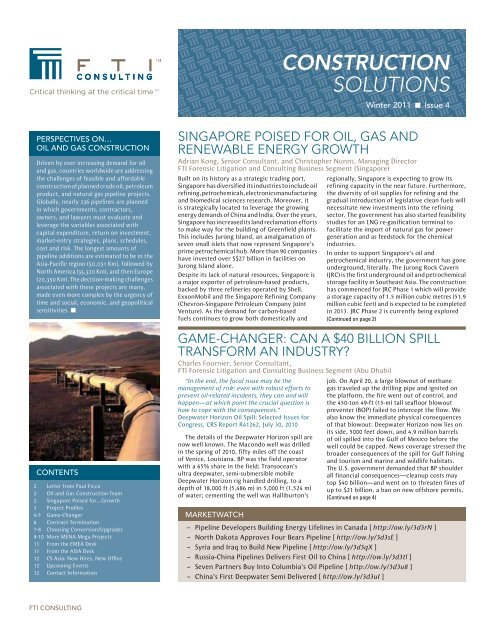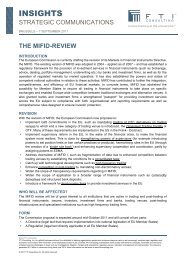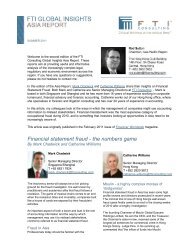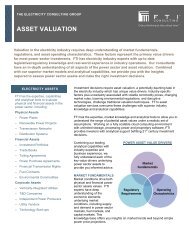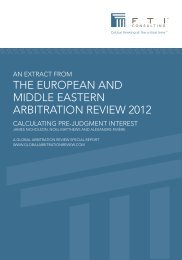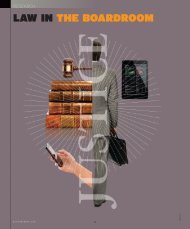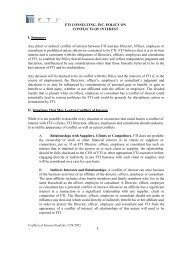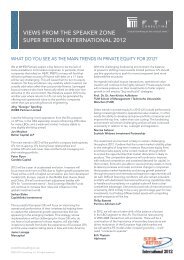construction solutions - FTI Consulting
construction solutions - FTI Consulting
construction solutions - FTI Consulting
You also want an ePaper? Increase the reach of your titles
YUMPU automatically turns print PDFs into web optimized ePapers that Google loves.
Critical thinking at the Critical Time TM Construction Solutions Winter 2011 ■ Issue 4<strong>FTI</strong> PROJECT PROFILEs<strong>FTI</strong> SUPPORTS OWNER IN DEFENDING DELAY CLAIMS ON OIL PRODUCTION PROJECT IN MALAYSIATHE PROJECTTalisman (Malaysia) Ltd is a Canadian-owned oil and gasexploration and production company holding a licence toproduce oil and gas from fields in the South China Sea. In 2001Talisman appointed Hyundai Heavy Engineering, a Koreancontractor, to engineer, procure, install and commission a newproduction facility designated ‘Bunga Rey A’. The work wasorganised in two separate projects: onshore <strong>construction</strong> andoffshore installation. A number of events occurred during bothprojects that resulted in delay to oil and gas production. Liabilityfor the events, and the subsequent delay, was disputed and theparties agreed to refer the matter to arbitration under LCIA rules.THE BRIEF<strong>FTI</strong> was appointed by the solicitors acting for Talisman to actas Delay Analysis expert. The brief included investigating and<strong>FTI</strong> SUPPORTS MAJOR INDUSTRIAL GAS PRODUCER IN NEW VENTURE IN CHINAreporting on the contractor’s claims for delay and constructiveacceleration in relation to the onshore project, and for delay inrelation to the offshore project. The brief also required <strong>FTI</strong> to giveevidence as an Expert Witness in the arbitration hearing.KEY ACHIEVEMENTSFollowing detailed investigations, which included meeting andinterviewing Talisman’s witnesses, a report was prepared thatconcluded delay had occurred in the onshore project, there wasno evidence to support the contractor’s claim for delay andconstructive acceleration. Our investigation found that there wasa delay, although not to the extent claimed by the contractor.The parties’ experts gave evidence and were cross examined inthe arbitration. The tribunal found in favour of the contractor,although neither to the extent claimed by the contractor nor tothat opined upon by the contractor’s expert.■THE PROJECTThe Shenua Group is China’s largest coal producer. It hasproven reserves of 223 billion tons of high quality coal, spreadover 31,200 square kilometers of Inner Mongolia. As China’senergy demands increase and oil costs continue to rise, Chinahas decided to use some of its huge coal reserves to producesynthetic fuels, employing a technique developed by Sasol forSouth Africa. Such projects require large quantities of oxygenof which Air Liquide is a world leading provider, through its AirSeparation Unit technology.THE BRIEFIn order to submit a bid for the project, Air Liquide had to form aconsortium with a Chinese EPC contractor. Air Liquide chose TCC,China Tianchen Chemical Engineering Corporation (formerly theFirst Design Institute of the Ministry of Chemical Industry, ‘FDI’).We were commissioned to draft and negotiate the consortiumagreement and also to review the Scope of Work of TCC, toensure that all risks associated with the bid to Shenua werecorrectly shared.KEY ACHIEVEMENTSFollowing the review and drafting of the Consortium Agreementin Paris, we travelled with the Air Liquide team to their offices inHang Zhou, China for final negotiations with TCC. Three days ofdirect negotiations followed, which resulted in the official signingof a consortium agreement between TCC and Air Liquide.■HAYNESVILLE PIPELINE EXPANSION PROJECT NORTHWEST LOUISIANATHE PROJECTRegency Energy Partners engaged <strong>FTI</strong> Construction Solutions toassess current systems, processes, and management tools relatedto the company’s management of $650 million worth of capitalprojects and to assist in the implementation of recommendedimprovements.KEY ACHIEVEMENTS<strong>FTI</strong> helped Regency make significant process and systemimprovements. Regency has continued to retain <strong>FTI</strong> to assist inoptimizing the organizational maturity of their projects divisionas they continue their plan for capital expansion.■THE BRIEFThe improvements that <strong>FTI</strong> recommended for the project controlsenabled Regency Energy Partners to monitor the costs andschedule in real time, so that management could be proactive toremedy situations that arose.INTERNATIONAL ARBITRATION PROCEEDINGS IN MEXICOTHE PROJECTIn 1997, the national oil company of Mexico, Petroleos Mexicanos(PEMEX) identified strategic projects to be part of a multi-billiondollar expansion of Mexico’s oil industry with the objective ofstrengthening the energy sector. The projects were to be financedby a capital investment plan hinging on the investment of privatecompanies in the form of project financing. Credits awarded byinternational banks to private firms that won contracts wereto be repaid as the projects completed and started to generaterevenue. The modernization of the Ing. Hector R. Lara SosaRefinery located in Cadereyta de Jimenez, Nuevo Leon, Mexico(Cadereyta Project) was one of the first projects to be financedprimarily by such credits. Cadereyta Refinery produces the fuelused in the northern part of the Mexican Republic, occupying anarea of approximately 5.9 square kilometers for the process units.THE BRIEFThe Cadereyta Project is unprecedented, huge-scale <strong>construction</strong>intended to double the production of unleaded gasoline, dieseland kerosene as well as dramatically improve environmentalprotection. PEMEX awarded the Cadereyta Project toCONPROCA, an international consortium formed for thepurpose of performing the detailed engineering, procurement,<strong>construction</strong> and commissioning for the Project. The scope ofwork also included the modernization and rehabilitation ofcrude oil and processed products pipelines, pumping stations,regulation and measurement stations and the modernization offour northern area terminals. The Project required 234,440 cubicmeters of concrete foundations, 8,174 tons of steel structures,2,300 pieces of mechanical equipment weighing approximately(Continued on page 8)Fti COnsulting [ 3 ]
Critical thinking at the Critical Time TM Construction Solutions winter 2011 ■ Issue 4Lawyer PerspectiveCONTRACT TERMINATION: LOOK BEFORE YOU LEAP!Fiona Parkin, Atkin Chambers Barristers (London)In the optimism which characterises thetendering and subsequent awarding of EPCcontracts it is probably unusual for the partiesto focus on understanding what their respectiverights might be to bring their commercialrelationship to an end mid way through theproject. The not uncommon result is that it isonly if the relationship sours (usually on the backof one or other party having reached the viewthat they have concluded a bad commercialdeal from which they need to escape) thatany attention at all is paid to the contractualmechanisms which provide for a way out.Those mechanisms once examined oftenreveal that the party wishing to escape has tojump through a series of hoops in order to doso (for example by ensuring that the situation inwhich they then find themselves falls within theambit of one or more of the scenarios in whichthe contract permits termination; that theyhave complied with the often complex noticeprovisions; and that they have adhered to anydefined “cure” period frequently provided to theparty alleged to have been in default).Moreover, once those hoops have beenjumped through, it is not uncommon tofind that the final accounting exercise whichis prescribed to follow from a contractualtermination, does not provide the disappointedparty with the financial recompense for whichhe might have hoped (frequently becauserecovery is circumscribed by limitation ofliability clauses which seek to exclude recoveryof future profits or otherwise limit the categoriesof recoverable loss).The aggrieved party might therefore beforgiven for concluding that seeking to operatethe contract termination provisions are moretrouble than they are worth and for wonderingwhether instead that the old fashionedEnglish common law rights of termination for“repudiatory” breach (namely breaches whichgo to the root of the contract) might be ofmore assistance. The answer to that questionwill of course be informed by the precisewording of the contractual termination regimeunder consideration. Sometimes contractsprovide a more advantageous route throughto disappointed parties than that availablefollowing the exercise of common law remedies.Sometimes they do not.Thus, whilst the ability to accept a wrongfulparty’s “repudiatory” conduct gives the partyseeking to escape from a contract an automaticright to terminate (which, importantly will notbe the subject of any “notice and cure” periodtypically imposed by EPC contracts and whichmight also in certain circumstances provide ameans of avoiding restrictive recovery of lossprovisions), it is often difficult to establish thata breach is a “repudiatory” one. There may alsobe other difficulties in proving one’s loss of abargain.The question of whether common law rightsof termination still exist when the parties’ owncontract also contains detailed provisions inthis regard is one which has been consideredrecently by the English Court of Appeal inStocznia Gdynia SA v. Gearbulk Holdings[2009] EWCA Civ 75. The Stocznia case aroseout of contracts to build six vessels in a wellknown Polish shipyard. The purchaser soughtto terminate the contracts by exercising hiscontractual rights to do so. It then went onto claim that it was entitled to recover lossand damage on the normal common lawbasis (namely loss of a bargain). The shipyardcontended that having exercised a contractualright to terminate, the purchaser was thereforelimited to recovering the (significantly smaller)categories of loss prescribed by that contract.Two of the issues with which the Court ofAppeal was concerned were: (1) whether thecontractual code for termination excluded thecommon law right to do so, and (2) whether thecontractual provisions governing quantificationand recoverability of loss consequent upontermination excluded claims for damages atcommon law.The Court of Appeal answered “no” toboth questions. Although the Court based itsreasoning on the proper <strong>construction</strong> to beafforded to the precise terms of the contractsthere under consideration, Moore-Bick LJ alsogave valuable guidance as to how contractualtermination clauses in general should beconstrued.The Lord Justice noted in paragraph 14 of hisjudgment that when commercial parties enteredinto contracts of this kind, they did so “in theexpectation that if the one of them commits abreach which goes to the root of the contract …the other will be entitled to recover damages forthe loss of his bargain.”He accepted that in certain circumstances,the words which parties chose to use in theircontracts would exclude their common lawtermination rights, but concluded that clearwords would be required in order to achievethat effect. He stated in paragraph 23 (inanswering question (2)): “The court is unlikelyto be satisfied that a party to a contract hasabandoned valuable tights arising by operationof law unless the terms of the contract makeit sufficiently clear that that was intended. Themore valuable the right the clearer the languagewill need to be.”Whilst Stocznia keeps alive two exit routes forparties seeking a way out from their contracts,it remains important for those who wish todo so to undertake a careful evaluation ofwhich route is the more advantageous (bothin terms of the factual threshold to be met totrigger an entitlement to terminate, and thefinancial consequences which might follow). Themessage is simple: Look before you leap!■Lawyer PROFILEFiona ParkinAtkin Chambers BarristersLondon+44 (0) 20 7404 0102fparkin@atkinchambers.comwww.atkinchambers.comFiona Parkin advises and represents multi-national companies, public bodies and professional clients inconnection with substantial international and domestic disputes, both within the UK and worldwide. Herspecialist areas include work in the <strong>construction</strong> and engineering, energy and utilities and professionalnegligence sectors. She also has a well established public procurement practice, advising public bodiesand unsuccessful tenderers on all aspects of Public and Utilities Procurement. Fiona has extensive experienceof high value commercial litigation and international arbitration work. In particular, she has advisedand acted in international disputes governed by ICC, UNCITRAL, LCIA and IBA Arbitration rules. She isrecognised as a leading junior by the legal directories, Chambers and Partners Guide to the Legal Profession(UK and Global) and The Legal 500, in the fields of Construction, Energy and Natural Resources, Arbitration,Professional Negligence and Public Procurement.Fti COnsulting [ 6 ]
Critical thinking at the Critical Time TM Construction Solutions Winter 2011 ■ Issue 4Lawyer PerspectiveSPECIAL CONSIDERATIONS WHEN CHOOSINGCONVERSION/UPGRADESRaja Bose, Partner and Ian Fisher, AssociateK&L Gates LLP, Singapore - Arbitration and International DisputesFor over two decades, the international disputes team of K&L GatesLLP’s Singapore location, have been identifying the underlyingreasons for cost overruns and delays on large <strong>construction</strong>projects, discussing what can be done to avoid such problems,and providing insight on what should be done once a dispute hasarisen in order to limit damages and win disputes. This litigationand arbitration experience also has been applied to the conversionand/or upgrade of offshore installations, such as FPSOs (FloatingProduction Storage and Offloading) and other floating and fixedoffshore production facilities as well as MODUs (Mobile OffshoreDrilling Units).Newbuild projects and conversion/upgrade projects technicallymay be very different - for example the difference between aharsh environment jack-up rig and an FPSO – but the projectsare fundamentally the same. Both project types experiencecommon issues that can lead to disputes, such as: delay, costoverruns, and claims for additional work. While disputes do arisein connection with newbuild projects, the conversion/upgradeprojects are notorious for generating disputes. Rarely, if ever, dothese types of projects complete on time and on budget. Usually,for commercial reasons, an oilfield operator and contractor willopt for a conversion/upgrade rather than a new-build. Conversion/upgrades cost substantially less than newbuilds, and, in addition,have significant time benefits. For example, in relation to FPSOs itis widely quoted that the project lifespan for a conversion is 14-24months, whereas a newbuild would take nearly twice as long at24-30+ months.There may be other very good commercial reasons why aconversion/upgrade project may be the better option. For example,in a recent dispute, the owner made the decision to convert a3rd generation semi-submersible into an extreme harsh conditionrig instead of purchasing a newbuild. The owner reasoned that,because all the shipyards capable of building a newbuild at thetime were too busy, by the time they would have taken delivery ofa newbuild, the day rate would have likely dropped considerably.Therefore, it made commercial sense, because they would be ableto get an upgraded rig operating while the market remained strongand before their competitors could start operating newbuild rigs.The very nature of a conversion/upgrade contributes to the factthat disputes are more likely to occur. One of the most obviousfactors contributing to a potential dispute is the condition of theexisting structure, be it an old tanker or rig. Repeatedly, we seecases where both the owner and shipyard fail to fully appreciatethe actual condition of an old structure until the work is welladvanced. There may also be interface and integration issueswith the shipyard being required to incorporate new designs andmaterials within an existing structure in order to permit the newand old to operate together. It is absolutely vital that a proper 3Dsurvey of the existing structure be carried out and used as the basisfor the new design. We also have been involved in a case wherethe party responsible for the basic design failed to carry out sucha survey and instead used the as-built drawings of the existing rig(which was by that time more than 20 years old) as the basis forthe new design. That contributed to huge problems on the project,both in terms of additional structural work and the associateddelays. Perhaps unsurprisingly, there were dimensional differencesbetween the old as-built drawings and the actual structure,contributing to misalignment between the new and existingstructure.Another cause of delay and claims for additional work is a failureto carry out sufficient front end engineering or to achieve a designfreeze before commencing the <strong>construction</strong> work. On fast trackprojects there is often a desire to start <strong>construction</strong> work as soonas possible before the basic design is sufficiently complete. This canlead to a situation where the design and <strong>construction</strong> work is beingcarried out in parallel. This may not have an immediate impact asmuch of the early <strong>construction</strong> work may involve removals fromthe existing structure, but eventually it will impact the overallproject. On a recent matter, we handled the impact of paralleldesign and <strong>construction</strong> work that was not felt for about 12months, but by then, caused significant delay and disputed claimsfor additional and varied work.Many of the problems we see with disputed claims for varied andadditional work are those associated with contract administration,rather than that of contract structure or wording being too muchin favour of one party. In such cases, the contract will contain aperfectly adequate variation order mechanism, but either or bothof the parties fail or refuse to operate the agreed procedure asintended. Often we see a shipyard fail to adequately documentthe instruction received from the owner for the additionalwork. In addition, too often we see cases where the contractprovides that no additional work should be carried out beforea variation order is issued by the owner, yet the shipyard startswork on the understanding or promise that the owner will issuea variation order in due course, which then never happens. Itis understandable that a shipyard is keen to keep the owner, itscustomer, happy, but such behaviour usually leads to disputes. Itwould be preferable for the shipyard to take a more robust attitudewith the owner and follow the contractual variation procedurefrom the beginning of the project, as closely as possible.There are steps which can be taken to avoid a dispute. The mostimportant of these include the following:• Have a balanced contract regime through realistic andreasonable contract terms;• Correctly apply contract terms during the project, inparticular the variation order procedure;• Employ proper project management. This involves being proactiveand trying to anticipate issues rather than waiting untilissues arise and thereby necessitating a response.(Continued on page 8)Fti COnsulting [ 7 ]
Critical thinking at the Critical Time TM Construction Solutions winter 2011 ■ Issue 4SPECIAL CONSIDERATIONS WHEN CHOOSINGCONVERSION/UPGRADES(Continued from page 7)• Communication with a counterpart is important, and shouldbe reasonable, responsive, and consistent.• Seek technical and legal input and support during the project.Investing in the expertise of lawyers and consultants whilethe project is ongoing can be extremely cost-effective; willhelp clients better manage risks; and will help clients avoidexpensive litigation or arbitration should a dispute escalate.When litigation or arbitration does commence, there are still stepsthat can be take to control that process. Working with experiencedand highly skilled lawyers and arbitrators will help guide youthrough the maze of laws and rules which govern dispute andarbitration centres. ■Lawyer PROFILESRaja Bose, PartnerK&L Gates LLP – Singaporeraja.bose@klgates.com+65.6507.8125Mr. Bose is a partner in the Singapore office of K&L Gatesand leads the firm's international arbitration and commercialdisputes practice in Asia. He has more than 18 years experiencein international arbitration and cross-border commerciallitigation and has worked in both London and Singapore. Mr.Bose concentrates his practice in international commercial dispute resolution and inaddition to his work in international arbitration he also has considerable experiencesupervising, coordinating and managing complex litigation in a wide number ofcountries in the Asia-Pacific region including South Asia, Indo-China and South-EastAsia. He has broad experience conducting international arbitrations with seats in Singapore,Hong Kong, Indonesia, Vietnam, China, India, Dubai, Malaysia, London, Paris,Geneva and New York under a variety of ad-hoc, trade association and internationalarbitration centre rules including UNCITRAL, LCIA, LMAA, GAFTA, CIETAC, BANI,HKIAC, KLIAC, SIAC, ICC, ICDR/AAA, VIAC and ICSID. ■Ian Fisher, AssociateK&L Gates LLP – Singaporeian.fisher@klgates.com+65.6507.8117Mr. Fisher is an Associate with the International Arbitrationgroup of K&L Gates, and is based in the Singapore office. Heis a qualified English solicitor with more than eight years postqualificationexperience and he has also worked in Londonand Tokyo as well as Singapore. Mr. Fisher concentrates hispractice on international arbitration and dispute resolution with a particular emphasison shipping, <strong>construction</strong> (offshore, marine, building and infrastructure) and insurance(both non-marine and marine) disputes. He has experience conducting internationalarbitrations with seats in numerous countries under various auspices includingUNCITRAL, ICC, LCIA, SIAC, SCMA and LMAA. Ian also has substantial experienceconducting litigation proceedings before the English High Court. ■(Continued from page 2)<strong>FTI</strong> PROFILESAdrian KongSenior Consultant<strong>FTI</strong> Forensic Litigation and <strong>Consulting</strong> BusinessSegment (Singapore)adrian.kong@fticonsulting-asia.comAdrian Kong is a Senior Consultant in the Forensic Litigation and <strong>Consulting</strong> BusinessSegment, Construction Solutions Asia, and is based in Singapore. Prior to<strong>FTI</strong>, Adrian worked with PETRONAS (national oil company of Malaysia) in variouscapacities, including <strong>construction</strong> management. Adrian also has served as siterepresentative for Sarawak Shell Berhad. In addition to his site experience, Adrianwas an analyst and evaluated cost, schedule and performance of large internationaloil and gas projects. ■Christopher NunnsManaging Director<strong>FTI</strong> Forensic Litigation and <strong>Consulting</strong> BusinessSegment (Singapore)65 6831 7822 - office65 8200 5982 – mobilechristopher.nunns@fticonsulting-asia.comChristopher Nunns is Managing Director of Construction Solutions Asia for theForensic Litigation and <strong>Consulting</strong> Business Segment of <strong>FTI</strong> <strong>Consulting</strong> Inc. MrNunns has over 30 years experience in the international <strong>construction</strong> industry workingwith both contractors and consultants. For the last 25 years he has been basedin Singapore and principally involved in dispute resolution, arbitration, contractadministration and claims management. He has given expert evidence for arbitrationand court proceedings on numerous occasions and is a regular speaker at seminarsand conferences in Singapore. He is a Contracts Advisor to the Singapore ContractorsAssociation Ltd and accredited as an adjudicator in Singapore. Mr Nunns iscurrently Chairman of the Society of Construction Law in Singapore. ■<strong>FTI</strong> PROJECT PROFILEs …continued(Continued from page 3)INTERNATIONAL ARBITRATION PROCEEDINGS IN MEXICO43,500 tons and 46,000 tons of piping. The approximate length of the Block 4 pipeline inplace was 1,930 kilometers. Approximately 5,700 kilometers of cable were installed alongwith 19,000 instruments and 420 electric cabinets, 1,059 kilometers of 24-inch pipingand 235 kilometers of 12-inch piping. The Project encountered various interferences anddisruptions resulting in delayed Project completion, resulting in significant cost impacts toCONPROCA. Consequently, CONPROCA prepared and filed a claim for damages and wasanswered in counter-claim by PEMEX.KEY ACHIEVEMENTSSteven Huyghe, Head of <strong>FTI</strong> Construction Solutions Asia was retained as Expert Witnessby CONPROCA to render expert consultation including Expert Technical Reports, Rebuttalsand Testimony relative to the claims of the Consortium and counter-claims of PEMEX.Steven Huyghe recently has completed testifying and the case has been turned over to theArbitration Tribunal for their deliberation. ■Fti COnsulting [ 8 ]
Critical thinking at the Critical Time TM Construction Solutions Winter 2011 ■ Issue 4From the emea deskGeoff BrewerHead of Construction Solutions/EMEAgeoff.brewer@fticonsulting.comFrom the Asia DeskSteven A. HuygheHead of Construction Solutions/Asiasteve.huyghe@fticonsulting-asia.comFollowing the unprecedented cuts in public investmentannounced by the UK government this summer, forecastssuggest that the <strong>construction</strong> industry will reach its nadirin 2011 as public sector money dries up. Beyond 2011, areturn to modest growth is anticipated. Against this difficultbackground, UK <strong>construction</strong> businesses have to carefullymanage their resources, adopt cautious risk strategies andensure that the contractual and commercial proceduresapplied to their projects are more protective of their intereststhan ever before. The Construction Solutions practice at <strong>FTI</strong>is being engaged by a growing number of clients to advisethem on the systems and controls they must institute tooperate successfully in these difficult conditions. Elsewhereacross the EMEA region, the economic climate is lesschallenging. Throughout the Middle East confidence isreturning. In Dubai, many stalled projects are being recommenced.Confidence will be particularly high in Qatar,having this week successfully won in its bid to host thefootball World Cup in 2022. This event has to be organized inJuly, when temperatures can soar to the high 40s (celsius,100s fahrenheit). Not a problem, say the Qataris, as the firstfive proposed stadiums will employ cooling technologycapable of reducing temperatures within the stadium by up to20 degrees. Additionally, the upper tiers of the stadiums willbe dismantled after the World Cup and donated to countrieswith less developed sports infrastructure. <strong>FTI</strong> ConstructionSolutions has been active in Qatar for some time now. Ournew office will open in Doha early next year and we hope toplay a proud part in supporting Qatar in its ambitious and boldplans for 2022. ■The dynamics of the global oil and gas industry are changing.Oil and gas <strong>construction</strong> in Asia, as elsewhere, will relyon the sustainability and pace of the global economicrecovery and future energy demand, as well as technologyand innovations that will help to optimize value from bothconventional and unconventional energy resources. Energystatistics from the EIA (Energy Information Administration)indicate that the growth in global oil consumption, especiallyfor China, remains strong. With China, the Middle East, andBrazil, they represent the most expected growth in world oilconsumption in 2011.It is forecasted that $193 billion will be spent on onshorepipeline projects worldwide through to 2015. Regionally, thefocus for development activity will be concentrated in Asia,Eastern Europe, the former Soviet Union, and North America.Asia stands out as the largest forecast market – by bothlength of pipeline <strong>construction</strong> (over 59,000 km of pipelines)and associated expenditure (over $55 billion). In Asia, soaringenergy demand is set to continue to support strong levels ofinvestment in domestic pipeline networks, as well as manytrans-national and trans-regional projects designed to helpmeet long-term energy requirements.We are exciting about our progress in the Hong Kong,Singapore, and Shanghai regions, and as a team we lookforward to providing exemplary Project Advisory, DisputeResolution, and Risk Management services to our growinglist of clients. ■Fti COnsulting [ 11 ]
Critical thinking at the Critical Time TM Construction Solutions winter 2011 ■ Issue 4CS ASIA: NEW HIRES AND NEW OFFICE IN SINGAPORE<strong>FTI</strong> Construction Solutions-Asia is workinghard to position our <strong>construction</strong> expertisein these key regions: Hong Kong, Singaporeand Shanghai. In November, we opened anew Construction Solutions (CS) office inSingapore. This new office will address theburgeoning <strong>construction</strong> industry projects inthe region. Christopher Nunns (christopher.nunns@fticonsulting-asia.com) has joined theSingapore office as Managing Director withbusiness development responsibilities for theregion while continuing to provide exemplary<strong>construction</strong> consulting advice. Prior to <strong>FTI</strong>,Chris was engaged in dispute resolution,arbitration, contract administration, andclaims management. Chris has given expertevidence for multiple arbitration and courtproceedings and frequently is invited to speakon various <strong>construction</strong> topics at <strong>construction</strong>seminars and conferences in Singapore.With specific regards to oil and gas, wehave added Adrian Kong (adrian.kong@fticonsulting-asia.com) as a Senior Consultantbased in Singapore. Prior to joining <strong>FTI</strong>, Adrianworked with PETRONAS in various capacities,responsible for <strong>construction</strong> managementof topside modules and offshore platforms.Adrian also has served as site representativefor Sarawak Shell Berhad. In addition tohis site experience, Adrian has worked asan analyst in evaluating the cost, scheduleand organization performances of largeinternational oil and gas projects.Fook Thim “FT” Chan (ft.chan@fticonsultingasia.com)has also joined our team as aSenior Consultant in Singapore and he has atremendous amount of experience in projectscheduling and dispute resolution. As aforensic programmer, FT has been engaged innumerous delay and disruption claims in theAsia Pacific region and advised clients on timerelatedmatters. Prior to his consulting career,FT served public agencies in both Singaporeand Taiwan.The CS Hong Kong office welcomes GrahamMcNeill (graham.mcneill@fticonsulting-asia.com) as a new Managing Director for thatregion. Graham has extensive experience inAsia, having worked in Hong Kong, Japan, andTaiwan with some of the largest employersand contractors in the <strong>construction</strong> industry.Before joining <strong>FTI</strong>, Graham was engaged indispute management, dispute resolution,contract administration, and commercialmanagement. Graham is well versed in bothCivil Engineering and Building Contracts, hehas worked as a Quantum Expert Witness,and he is recognized for his work in a rangeof disciplines, including procurement andcontract strategy, commercial management,post contract management, and disputeresolution for large blue chip employers,contractors and sub-contractors. As aManaging Director in the Hong Kong office, hewill have business development responsibilitiesin addition to providing <strong>construction</strong>consulting advice.■CS Asia Holiday GatheringTeam members from <strong>FTI</strong> Construction Solutions-Asia assembled for a holiday gathering withspouses and friends.Top row, left to right - Tsang Wong, Steve Huyghe, Christopher Nunns, Graham McNeill, Chris Jackson.Bottom row, left to right - Sharon Jackson, Natalie Huyghe, Joanne Wong, Denise Puffler.UPCOMING EVENTSJan 20-21, 2011ABA Joint Mid-Winter MeetingNew York, NYMar 31-Apr 2, 2011Florida Bar AssociationMembership MeetingOrlando, FloridaCONTACT INFORMATIONAMERICAS+1.206.689.4480<strong>construction</strong><strong>solutions</strong>@fticonsulting.comEMEA+44 (0) 20 7389 3800brewer@fticonsulting.comCorporate Offices500 E. Pratt StreetSuite 1400Baltimore, MD 21202 USAASIA+852.3120.8643steve.huyghe@fticonsulting-asia.comwww.fticonsulting.com©<strong>FTI</strong> <strong>Consulting</strong>, 2011. All rights reserved. The commentaries in this publication are the express perspectives and opinions of the individual authors and are not necessarily theviews of <strong>FTI</strong> <strong>Consulting</strong>, Inc. or its other professionals.Fti COnsulting [ 12 ]


